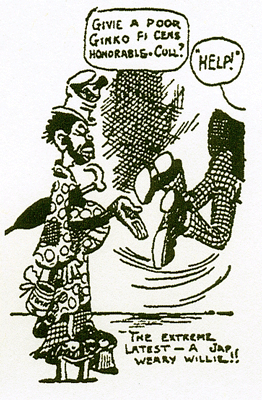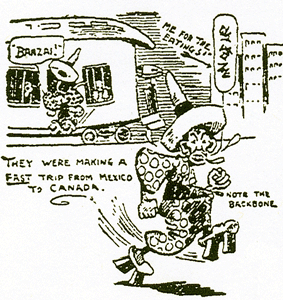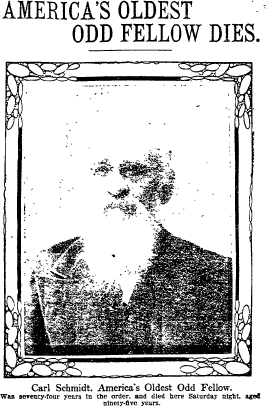Matrimonial Accounting
 Oct. 16, 1907
Oct. 16, 1907Santa Ana
George S. Best is a great believer in marriage and strongly opposes divorce, which is why he has three of one and none of the other.
His most recent troubles began when his wife Anita discovered that he had married young Cecile Fleming, the daughter of a prominent local businessman. Upon investigation, Anita Best of Los Angeles and Charles Fleming of Santa Ana discovered that Best had married Cecile in back of the county clerk
Fire Threatens Orpheum


 Oct. 15, 1907
Oct. 15, 1907Los Angeles

On a rainy night in Los Angeles, a fire broke out in the four-story brick office building at 235 S. Spring St. housing the Orpheum Theater and the Elks Hall, which was engulfed in panic as visitors at a Japanese festival rushed for the exits. The second-floor hallways were so jammed that members of the Elks Club rushed to the rear of the building to use the fire escapes.
At Orpheum, on the floor above the Elks Club, veteran actress Minnie Seligman calmly made the smoke and the sound of fire engines part of her skit. Rushing offstage for a moment, she returned covered with soot and announced:
Nine Out of Ten
Two Die in Tong War

Oct. 13, 1907
Los Angeles
Gunmen imported from out of town by the Hop Sing Tong entered the tailor shop of Lem Sing at 806 Juan St. in Chinatown and under the pretense of having some clothing made, wounded him when he turned to reach for some material. The men also killed Wong Goon Kor, who was, according to The Times,
A Foul Wind Blows Over Boyle Heights

Oct. 12, 1907
Los Angeles
After repeated complaints to police because half a dozen dead dogs had laid in the streets for two weeks, the health department tried to charge C.T. Hanson, who held the contract for removing carcasses. But according to the city attorney, Hanson was only guilty of not abiding by his contract and nothing more.
In fact, Hanson had tried to get out his contract, claiming that he was losing money, but the city refused.
Death of a Millionaire
The Want Ads
Rail Bums, Japanese-Style

October 9, 1907
Los Angeles
Where now we fret over every Mexican and Saudi, uh, Iraqi who crosses our border, time was, we fretted over the Japanese. And rightfully so—they are studious and upright, and therefore cunning. Oh, wait, that was the stereotype concocted after 1941. In 1907, they were all hungry railroad tramps.
You will I trust forgive me while I quote liberally from the original text:
“Sound the alarm…the Japs have scaled the last wall of our complicated civilization. Having learned how to work, they are now starting in on the science of learning how not to work—invading Vagobondia. In fact the first crop of oriental Happy Hooligans was reaped yesterday morning.”
M. Mitsuz and R. Moresons traveled from Japan to Mexico in search of work. They worked Down South for a spell, “but for some queer reason got an inspiration to go with a trainload of Jap emigrants to Vancouver, where Japs get clumped around by the natives.”
The two aforementioned gentlemen were piled into a cheap day coach, and were “transported over more miles than they thought were on the globe.” Having made the journey from Japan, this writer feels that to be, likely, highly inaccurate. In any event, there was apparently no food on the train, as Mitsuz, “who is about the size of a pickled onion, murmured in his dreams the names of luscious Jap dishes that made his pal, Moresons, groan aloud. When the train passed any place where there were restaurants, their two little noses twitched and sniffed like rabbits.” Again, without there having been a reporter on the train with them, we can only marvel at the describatory liberties taken herein. But such was the deft and trenchant reporting of the time.
With dame hunger having taken hold, though while under bond and legally not allowed to leave the train, Mitsuz and Moresons beat it out of the railroad yards and into the nearest eatery: “They had their first introduction to their ‘ham an,’’ and somebody scooped out for them a restaurant pie resembling two clam shells, with a piece of felt hat for filling. They devourered it and suffered grievous things in their tummies during the night. Japanese nightmares, having all those crawly things you see shinning up the sides of rose vases for literary material, must be something fierce.”
That may be so. (I invite those readers of Japanese ancestry to confirm and clarify.)
While at the beanery, where our duo “ate until their skins were spread thin,” the train up and left without them, taking all of their belongings with. They ran around for a while, making “rag-time” gestures at officials, who dutifully ignored them. They climbed into a boxcar hoping to hop a freight north, but were pinched by railyard bulls, who “rounded them into the station with the regular grist of Weary Willies and tomato can bums.”
Messrs. Mitsuz and Moresons face deportation.
The Oddest, Oldest Fellow
October 9, 1907
Los Angeles
The nation’s most senior Odd Fellow, Carl Schmidt of 2729 West Pico Street, died at aged 95, after a brief illness. Schmidt was born in Germany in 1812, and emigrated to Philadelphia at 18, where he was known as a locksmith of great facility. He joined the Odd Fellow’s Lodge No. 12 at 21, and in 1852 moved with his wife Joanna to Madison, Wisconsin, then a tiny trading post, where he co-founded Lodge No. 17. He maintained active memberhip in this lodge until his passing.
Joanna Schmidt died in 1900, and the following year Carl moved to Los Angeles to live with their daughter, Mrs. Gus Kleaman. A week before his death, Schmidt gained the distinction of being the oldest person to spend an hour under anesthesia, as surgeons attempted to repair a rupture he had suffered at age 8, which had lain fallow for eight decades before becoming an irritation. He appeared to rally from his surgery, but complications set in, and he died at home surrounded by his family. The funeral was held at his bedside, under the auspices of the Odd Fellows.








